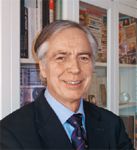Fernand Sauer: The Essential—and Effective—Bureaucrat
Fernand Sauer, First Director General, European Medicines Agency
When I took charge of the European Union Commission's Pharmaceutical Unit some 30 years ago, the pharmaceutical market in Europe was very fragmented. National legislation followed different traditions. Only a few countries possessed a reliable regulatory authority. In most countries the evaluation process was weak and slow. Sometimes, it was biased toward local interests that fostered a climate of corruption. Over a period of 15 years, my work was to design, negotiate, and implement 13 key proposals leading to the establishment of a single European market for human and veterinary medicine, including testing requirements, good manufacturing practices, approval procedures, labeling, inspections, advertising, and price transparency.

Fernand Sauer
While this was in progress, I approached the FDA, the Japanese authorities, WHO, and the research-based industry. As a result, the International Conference for the Harmonization of pharmaceutical requirements (ICH) was born and the first major conference took place in Brussels in 1991. Twenty years later, preclinical and clinical presented in a common technical dossier are acceptable to all major regulators.
The final step consisted in the establishment of the European Medicines Agency in London in 1995 to evaluate novel products, leading to a single European market authorization. As the first director of the EMA, my task was to set up entirely new scientific, administrative, and financial structures and procedures. I had to mobilize the relevant expertise from national regulatory authorities, pointing to a long-term vision for Europe while listening carefully to ideas from colleagues and stakeholders.
Over the last 16 years, some 700 European marketing authorizations for innovative products have been issued within strict time frames and to high standards, comparable to those of the FDA. From the start, I promoted transparency at the EMA by publishing all evaluation reports on the Internet. I introduced a culture of quality management, periodic improvements, and avoidance of conflicts of interest within the EMA's technical secretariat and scientific committees. I tested various approaches to motivate internal and external experts: pride in the quality of their peer review, international recognition, optimal working conditions, and a sense of collective achievement through good science and friendship.
The cooperation between EMA, FDA, and other major agencies has provided clear and reliable regulatory advice and decisions during R&D and at pre- and post-marketing stages.
After successive enlargements of the European Union, the pharmaceutical harmonization, now covering 27 Member States as well as Norway and Iceland, has become a model in other parts of the world. As a multicultural networking organization, the EMA must constantly review and improve its operations, as outlined in the "EMA Road Map to 2015."
When I became the Director for Public Health of the European Commission in 2001, I actively promoted the inclusion of health products in the general development of European health policy, starting with orphan drugs, rare diseases, and health technology assessments. I contributed to launch the European Centre for Disease Control in 2005, which worked with EMA on vaccinations, pandemics, and antimicrobial resistance. I encouraged the Innovative Medicines Initiative for public/private collaboration involving EMA and industry under the European Research Program.
Since 2010, pharmaceuticals and medical devices are fully integrated in the new public health competencies of the European Union. The activities of the EMA are of direct concern to more than 500 million citizens whose expectations must be satisfied in a democratic and scientifically sound way, especially in the case of incidents and safety alerts.
Over the past 30 years I have admired the talent of industry researchers in getting better products to the patient. At the same time, I have witnessed the progressive sterilization of innovative research due to a trend toward ever-larger industry concentration. The dominance of short-term financial considerations have led to the current "blockbuster model" impasse. Like other innovative sectors such as electronic goods, industry research efforts must be redirected towards cheaper and more cost-effective solutions for payers and patients or it will lose ground against a tide of Chinese, Indian, and Brazilian competitors.

Addressing Disparities in Psoriasis Trials: Takeda's Strategies for Inclusivity in Clinical Research
April 14th 2025LaShell Robinson, Head of Global Feasibility and Trial Equity at Takeda, speaks about the company's strategies to engage patients in underrepresented populations in its phase III psoriasis trials.
Beyond the Prescription: Pharma's Role in Digital Health Conversations
April 1st 2025Join us for an insightful conversation with Jennifer Harakal, Head of Regulatory Affairs at Canopy Life Sciences, as we unpack the evolving intersection of social media and healthcare decisions. Discover how pharmaceutical companies can navigate regulatory challenges while meaningfully engaging with consumers in digital spaces. Jennifer shares expert strategies for responsible marketing, working with influencers, and creating educational content that bridges the gap between patients and healthcare providers. A must-listen for pharma marketers looking to build trust and compliance in today's social media landscape.
Pfizer, GSK Gain ACIP Recommendations for RSV and Meningococcal Vaccines
April 18th 2025The Centers for Disease Control and Prevention’s Advisory Committee on Immunization Practices voted to expand access to Pfizer’s respiratory syncytial virus vaccine Abrysvo for high-risk adults in their 50s and voted in favor of GSK’s meningococcal vaccine, Penmenvy, for streamlined adolescent protection.